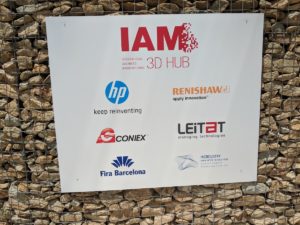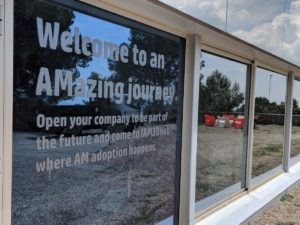 In Terrassa, about 30km north of Barcelona, a mountainside in part of a protected forest houses not only stunning views of the Spanish countryside, but a technological center focusing on managing and advancing progress. Leitat Technological Center, founded in 1906, accredited by ACCIÓ and recognized by the Ministry of Economy and Competitiveness, is now home to the International Advanced Manufacturing 3DHUB (IAM 3DHUB). The new collaborative center, founded by technological partners Leitat, HP, Renishaw, and Coniex, and with Fira Barcelona and IN(3D)USTRY, officially opens today, launching with a mission and a vision.
In Terrassa, about 30km north of Barcelona, a mountainside in part of a protected forest houses not only stunning views of the Spanish countryside, but a technological center focusing on managing and advancing progress. Leitat Technological Center, founded in 1906, accredited by ACCIÓ and recognized by the Ministry of Economy and Competitiveness, is now home to the International Advanced Manufacturing 3DHUB (IAM 3DHUB). The new collaborative center, founded by technological partners Leitat, HP, Renishaw, and Coniex, and with Fira Barcelona and IN(3D)USTRY, officially opens today, launching with a mission and a vision.
“To accelerate adoption and development of additive manufacturing and 3D printing technologies in the European Union manufacturing sectors as an alternative way to design, develop and manufacture new competitive products and services that strengthens their competitiveness,” the 3DHUB’s mission statement reads.
“Defined as a Digital Innovation Hub & Competence Center in Additive Manufacturing and 3D Printing will provide SMEs a ‘One-Stop’ Shop to assess, guide and address all their needs in AM,” reads the vision.
Following the conclusion of this week’s busy and engaging HP Global Innovation Summit held around Barcelona, I appreciated the opportunity to visit the IAM 3DHUB ahead of today’s inauguration. Sandra Pérez Martínez, Business Development, Leitat, and Iolanda Montserrat Siles, 3D Strategic Planning and Operations, HP, toured me through the brand-new facility for an inside look at its offerings and a discussion of a collaborative future.
“We are pooling our knowledge, our resources, our energy, and our willingness to transform the industry using and producing additive manufacturing technologies,” Montserrat told me.
“This is a private organization, and we decided we needed facilities. We have two floors, opening this week. It is a new facility to drive this vision. The focus is international in scope, impacting many European countries.”
The 3DHUB has a mission to accelerate adoption and development in 3D printing, Pérez added.
“The innovation hub is already recognized by the European Union. This is a one-stop shop for companies looking to adopt additive manufacturing, serving from the beginning to the end of the value chain. We are connecting this ecosystem. We are working to add more partners,” she said.
IAM 3DHUB currently has a 700-square-meter footprint, including shared labs, and the collaborative enterprise is already looking to broaden its scope and footprint. A major expansion is in sight for 2019 already, with a 12,000-square-meter space planned in Barcelona, and Montserrat noted that they can now confirm that there will be more space as well as more players involved, as they look forward to more good news coming soon regarding progress.
Looking to this initial phase, IAM 3DHUB provides five major areas of focus, as the pair laid out, including:
- Experimentation and testing
- End-to-end solutions
- Business and mentoring
- R&D
- Education and training
Pérez walked me through each of these facets, noting that benchmarking of additive manufacturing technologies and processes is an important focus, as the partners work to assess and validate 3D printing manufacturing capabilities. IAM 3DHUB offers incubators and pilot lines to validate production at the industrial scale, including metrology in this space as well as additional labs available through Leitat. The business and mentoring aspect offers expertise for both startups, with go-to-market strategies, and for supply chain development to accelerate adoption in more established organizations.
“As it is a new way of producing, there is not enough standardization or certification; there is a lot of work ahead to scale additive manufacturing at production,” Pérez said.
The pilot line available at IAM 3DHUB includes six Jet Fusion 3D printers from HP — with another two systems located on the lower level alongside metal 3D printing systems from Renishaw — where a team works to showcase production-level capabilities and build best practices, available to customers and prospective adopters.
“It is very different to manage one production than it is eight printers at the same time,” Montserrat noted. “We are helping in operations not only in technology, but how to manage production with printer farms. Software is, of course, also a big part of this, and we focus on training there as well.”
Training and mentorship are critical factors in accelerating adoption, both for students and for established businesses and employees. While adoption faces a significant barrier due to a lack of resources, IAM 3DHUB focuses on providing help for full end-to-end services, Montserrat underscored. Leading through example, the pilot plant and growing resources in terms of software, labs, hardware, and materials available at the 3DHUB allow for on-the-ground understanding of each area of 3D printing.
Among the hardware available at the facility, in addition to the industrial HP and Renishaw systems, are FDM from Stratasys, SLA from Formlabs, and plastic extrusion from BCN3D Technologies as well as a modified BCN3D system working with conductive inks. Ancillary and post-processing equipment includes sand blasters and vibrational polishing from Coniex, a dyeing system from DyeMansion, CNC milling, ovens, chillers, and more. All systems are installed with the intent to showcase and educate on the potential for real-world applications.
“The pilot plant upstairs has six MJF systems set up as they could be in a business, so we can show industrial users how it could look,” Pérez explained of the setup.
Montserrat added, “This is one of the largest MJF installations in Europe. This is very unique in Europe, having a farm of printers in a production environment, in a place open to the technology, to using and understanding its potential.”
We went upstairs at this point in our conversation to see this print farm installation. The space was set up very intentionally for best practice in workflow, from the design office and job preparation area to the adjacent production area and dedicated post-processing side. An ATOS ScanBox from Metronic allows for checking of final parts and creation of a final report for customers.
“We have a benchmarking area, to show customers when they are considering our technologies. We have an installation supporting 24/7 service, supporting all the world. We receive requests here and evaluate them; there is a huge variety of requests to work out approaches and to evaluate designs. Customers don’t always understand how to design for this process, so we ensure that this is optimized. We plan which printers to use — and a big advantage of this technology is that we can build more than one job at a time, the line is very efficient,” Montserrat told me.
“The layout of machines here is on purpose, so we can send jobs appropriately for material needs; each area supports different materials.”
Each of the three different material types has two dedicated MJF 3D printers and one processing station. Several build units are in use at the same time to ensure that the printers don’t have to stop. Following print jobs, finishing is up to what each individual customer wants, as different thresholds of quality are available, with polishing or dyeing available following cleaning. Metrology reports are available for customers with high compliancy needs. The lower level of the space includes a conference area setup for meetings, presentations, and training, along with the other two MJF systems and metal systems. Sample parts are on hand so visitors can examine parts, surfaces, finishes, and geometries.
“We are bringing customers in here to see what they need for space, for air quality, size, capacity, personnel, materials — they can understand and plan after they see it here,” Montserrat explained of the importance of the sharing of knowledge in such a format. “You do the journey, and learn from it, and share that experience with customers.”
Learning from the journey is a critical part of the underlying operations at IAM 3DHUB — as it is for additive manufacturing as a broader industry. Understanding comes through experience, and advances come from understanding — and from collaborating. With different technologies on site and partners with a variety of backgrounds and technological focuses, IAM 3DHUB offers an agile base of operations for continuing to build upon a community of knowledge.
“It is like a startup: we are always working, always learning, always looking to customer feedback from every visit. This is very important, and provides many ideas to work from. All participants’ R&D teams are connected here,” Montserrat said.
That startup mentality, which is increasingly seen as large global companies have smaller, agile teams focusing on new technologies including additive manufacturing, allows for a learning-based approach to enhancing adoption.
“This is the first innovation hub in Europe devoted to 3D printing,” Pérez noted, adding that it is involved in the EU’s Horizon 2020 program. “Having multi-branded spaces is beneficial for us all, and for the market.”
 Collaboration and shared technologies as showcased at IAM 3DHUB represent an all-important step forward for additive manufacturing. Through the open exchange of ideas and high-profile participants across a variety of technologies, the industry stands to benefit from a well-informed knowledge pool and the opening up of advanced technologies and processes to more users who could benefit. By targeting international relationships, IAM 3DHUB allows for a broad European focus as the region continues to devote resources to accelerating Industry 4.0 and the components thereof.
Collaboration and shared technologies as showcased at IAM 3DHUB represent an all-important step forward for additive manufacturing. Through the open exchange of ideas and high-profile participants across a variety of technologies, the industry stands to benefit from a well-informed knowledge pool and the opening up of advanced technologies and processes to more users who could benefit. By targeting international relationships, IAM 3DHUB allows for a broad European focus as the region continues to devote resources to accelerating Industry 4.0 and the components thereof.
Industrial 3D printing holds an important key to the future of manufacturing and a more digital, agile future for industry and innovation. The opportunity to see IAM 3DHUB was a heartening learning experience, and certainly left me with great hope for an open, collaborative future in advancing and accelerating adoption of best practices for new technologies.
More information about IAM 3DHUB is available here in the endeavor’s leaflet.
Discuss collaboration, adoption, and other 3D printing topics at 3DPrintBoard.com or share your thoughts in the Facebook comments below.
[All photos: Sarah Goehrke]
Subscribe to Our Email Newsletter
Stay up-to-date on all the latest news from the 3D printing industry and receive information and offers from third party vendors.
Print Services
Upload your 3D Models and get them printed quickly and efficiently.
You May Also Like
3D Printing News Briefs, June 11, 2025: Sustainability, Automotive Tooling, & More
We’re starting with sustainability news in today’s 3D Printing News Briefs, as EOS has strengthened its commitment on climate responsibility, and Zestep is making 3D printing filament out of eyewear...
3D Printing 50 Polymer Stand-In Parts for Tokamaks at the PPPL & Elytt Energy
Of all the world’s things, a tokamak is one of the hardest, most complex, expensive and exacting ones to make. These fusion energy devices make plasma, and use magnets to...
3D Printing News Briefs, May 17, 2025: Color-Changing Materials, Humanoid Robot, & More
We’re covering research innovations in today’s 3D Printing News Briefs! First, Penn Engineering developed 3D printed materials that change color under stress, and UC Berkeley researchers created an open source,...
Firehawk Aerospace Partners with JuggerBot 3D, Gets $1.25M from AFWERX for 3D Printed Propellants
Texas-based Firehawk Aerospace, an advanced energetic materials firm that works with aerospace and defense applications, announced a strategic partnership with JuggerBot 3D, an Ohio-based large-format 3D printer manufacturer. Together, the...










































